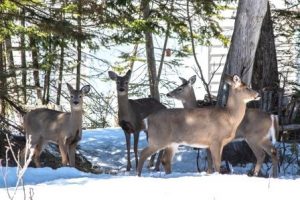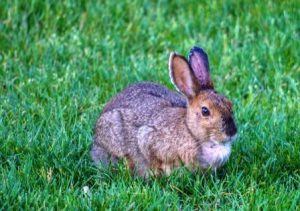Deer & Rabbit Resistant Perennials
DO THEY EAT EVERYTHING?
It may seem like everything gets eaten, but deer and rabbits do have their particular favourites. And, there are certain plants that they never touch. An internet search will turn up plenty of so-called “deer-proof” or “rabbit-proof” plant lists, but ANY list must be taken with a grain of salt. That’s because critters will sample or eat anything when populations are high and food is scarce. Also, populations may develop a taste for specific plants that deer and rabbits in other regions never touch. A list can only be a general guideline, and your experiences may be different from other gardeners. It might be helpful to ask local neighbours about which plants in their garden are being eaten and which are not.
We have assembled a list of our own, based on dozens of lists found all over the continent. Some of these plants are listed in our chart at the bottom of this post. You can find a much more extensive listing by using the Advanced Search feature on this website (www.perennials.com),
Rabbits and deer tend to avoid similar plants, but not always. In terms of deer, researchers have noticed they tend to stay clear of:
- Toxic plants – perhaps determined by their bad smell or taste
- Fragrant or aromatic plants – they don’t like strong odours
- Fuzzy leaves – to a deer these must feel like eating Velcro
- Ornamental grasses – most are untouched by deer, probably because their teeth can’t chew them
Rabbits will eat Blue Fescue and some others.
COMBINE SEVERAL STRATEGIES
We can avoid planting what deer or rabbits prefer to eat, but their favourites might already be growing in your garden. If that’s the case, you’ll need to use several tactics together to win the battle. Here are some suggestions:
- Learn when to expect trouble: monitor the local herd. If there are more deer around than usual, then expect trouble. Deer feeding in gardens can be particularly bad after a summer drought when wild food sources may be scarce.
- Protect vulnerable plants – particularly expensive shrubs and trees – or any plants that don’t appear on deer or rabbit-resistant lists. Use repellents right away on newly-planted favourites; don’t wait for the damage.
- Wrap or cage specific plants: sturdy materials such as snow fencing, poultry netting and deer fencing can be very effective when erected from fall to mid spring to protect vulnerable shrubs and trees. The Cary Institute of Ecosystems Studies website (caryinstitute.org) has excellent detailed instructions on how to go about this.
- Use repellents: newer products that combine bad smell and taste together seem to be more effective than older types. Reapply repellents every three weeks but follow the minimum temperature instructions on the label to avoid injuring plants. Repellents that are soap or egg-based are less damaging, but it’s always wise to test any repellent on a small portion of the plant first. Despite what product labels may claim, no repellent will work forever by just spraying it on once.
- Consider fencing: where deer browsing is really bad, a perimeter fence at least 8 feet tall enclosing the entire property has proven effective.
KNOW WHAT PLANTS TO AVOID
In general, the following perennials, shrubs and trees will often be nibbled or eaten, so it’s better to just avoid them if deer or rabbits are in the area. Your local garden centre will know if others that are a problem.
 Favourite Deer Plants: Apple and Crabapple, Aspen, Aucuba, Azalea, Birch, Blackberry, Blueberry, Cherry (including ornamental types), Chokecherry, Clematis, Crocus, Daylily, Eastern Redbud, Elderberry, Elm, English Ivy, Euonymus (especially Burning Bush), Fir, Flowering Dogwood, Hawthorn, Hemlock, Hibiscus, Hollyhock, Honeysuckle, Hosta, Hydrangea, Impatiens, Lilac (Korean), Lily (Lilium), Maple, Mountain Ash, Mountain Laurel, Oak, Peach, Pear, Phlox (Summer), Pine (especially Mugo and White), Plum, Poplar, Raspberry, Redbud, Rose (especially Hybrid Tea), Sedum (Autumn Stonecrop), Strawberry, Sumac, Trillium, Tulip, Vegetables (especially broccoli, cauliflower, beans, lettuce, peas, corn), Viburnum, Viola (especially Pansies), White Cedar (Arborvitae), Willow, Wisteria, Witch Hazel, Yew
Favourite Deer Plants: Apple and Crabapple, Aspen, Aucuba, Azalea, Birch, Blackberry, Blueberry, Cherry (including ornamental types), Chokecherry, Clematis, Crocus, Daylily, Eastern Redbud, Elderberry, Elm, English Ivy, Euonymus (especially Burning Bush), Fir, Flowering Dogwood, Hawthorn, Hemlock, Hibiscus, Hollyhock, Honeysuckle, Hosta, Hydrangea, Impatiens, Lilac (Korean), Lily (Lilium), Maple, Mountain Ash, Mountain Laurel, Oak, Peach, Pear, Phlox (Summer), Pine (especially Mugo and White), Plum, Poplar, Raspberry, Redbud, Rose (especially Hybrid Tea), Sedum (Autumn Stonecrop), Strawberry, Sumac, Trillium, Tulip, Vegetables (especially broccoli, cauliflower, beans, lettuce, peas, corn), Viburnum, Viola (especially Pansies), White Cedar (Arborvitae), Willow, Wisteria, Witch Hazel, Yew
 Favourite Rabbit Plants: Anemone (Japanese), Apple and Crabapple, Barberry, Campanula, Celosia, Clematis, Clover (Trifolium), Crocus, Deutzia, Dianthus, Echinacea, Euonymus (especially Burning Bush), Festuca (Blue Fescue), Forsythia, Hawthorn, Hydrangea (Oakleaf), Impatiens, Kerria, Lily (Lilium), Pear, Petunia, Phlox, Portulaca, Pyracantha, Quince (Flowering), Redbud, Rose, Sandcherry, Serviceberry, Snapdragon, Sunflower (annual), Sweet Pea, Tulip, Vegetables (many types), Verbena, Viburnum, Viola (especially Pansies), Zinnia.
Favourite Rabbit Plants: Anemone (Japanese), Apple and Crabapple, Barberry, Campanula, Celosia, Clematis, Clover (Trifolium), Crocus, Deutzia, Dianthus, Echinacea, Euonymus (especially Burning Bush), Festuca (Blue Fescue), Forsythia, Hawthorn, Hydrangea (Oakleaf), Impatiens, Kerria, Lily (Lilium), Pear, Petunia, Phlox, Portulaca, Pyracantha, Quince (Flowering), Redbud, Rose, Sandcherry, Serviceberry, Snapdragon, Sunflower (annual), Sweet Pea, Tulip, Vegetables (many types), Verbena, Viburnum, Viola (especially Pansies), Zinnia.
DARN THOSE CRITTERS!!
We spend a lot time, energy and money on our gardens and nothing is more frustrating than watching them get eaten to nubs by four-legged critters. This is a particular problem where new subdivisions have been built on the edges of cities and towns, but sometimes it’s even an urban problem. Surveys show that deer populations have exploded in recent years in certain regions, largely due to a lack of natural predators. If you’re trying to garden where deer are plentiful, this problem is not going to go away soon. Rabbit populations, on the other hand, tend to peak and fall regularly – some years will be worse than others.
Perennials that both Deer & Rabbits Avoid*
Botanical Name / Common Name
Achillea / Yarrow
Aconitum / Monkshood
Agapanthus / Lily-of-the-Nile
Agastache / Anise-hyssop
Ajuga / Carpet Bugle
Aquilegia / Columbine
Artemisia / Artemisia, Wormwood
Astilbe / Astilbe
Baptisia / False Indigo
Bergenia / Bergenia
Brunnera / Siberian Bugloss
Buddleia / Butterfly Bush
Calamagrostis / Feather Reed Grass
Cimicifuga / Bugbane
Coreopsis / Tickseed
Dicentra / Bleedingheart
Digitalis / Foxglove
Epimedium / Barrenwort
Eupatorium / Joe Pye-Weed
Euphorbia / Spurge
Ferns / Most garden forms
Gaillardia / Blanket Flower
Helleborus / Hellebore
Iris (but not Dutch Iris) / Iris
Lamium / Creeping Lamium
Lavandula / Lavender
Miscanthus / Maiden Grass
Monarda / Beebalm
Nepeta / Catmint
Paeonia / Peony
Papaver / Poppy
Perovskia / Russian Sage
Polygonatum / Solomon’s Seal
Primula / Primrose
Salvia / Perennial Sage
Stachys / Lamb’s-ears
Stokesia / Stokes’ Aster
Thymus / Thyme
Veronica / Speedwell
Yucca / Adam’s Needle
|